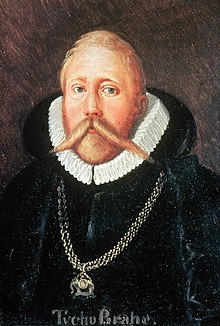Tycho Brahe
| Tycho Ottesen Brahe | |
|---|---|

Brahe wearing the Order of the Elephant
|
|
| Born | 14 December 1546 Knutstorp Castle, Scania, Denmark, Denmark–Norway (now Sweden) |
| Died | 24 October 1601 (aged 54) Prague, Habsburg Bohemia, Holy Roman Empire (now Czech Republic) |
| Nationality | Danish |
| Alma mater |
University of Copenhagen Leipzig University |
| Occupation | Nobleman, astronomer |
| Known for | Tychonic system |
| Spouse(s) | Kirsten Barbara Jørgensdatter |
| Children | 8 |
| Parent(s) |
Otte Brahe Beate Clausdatter Bille |
| Signature | |
 |
|
Tycho Brahe (/ˌtaɪkoʊ ˈbrɑːhi, ˈbrɑː, ˈbrɑːə/), born Tyge Ottesen Brahe (Danish: [ˈtˢyːə ˈʌd̥əsn̩ ˈb̥ʁɑː]; 14 December 1546 – 24 October 1601), was a Danish nobleman known for his accurate and comprehensive astronomical and planetary observations. He was born in the then Danish peninsula of Scania. Well known in his lifetime as an astronomer, astrologer and alchemist, he has been described as "the first competent mind in modern astronomy to feel ardently the passion for exact empirical facts." His observations were some five times more accurate than the best available observations at the time.
An heir to several of Denmark's principal noble families, he received a comprehensive education. He took an interest in astronomy and in the creation of more accurate instruments of measurement. As an astronomer, Tycho worked to combine what he saw as the geometrical benefits of the Copernican system with the philosophical benefits of the Ptolemaic system into his own model of the universe, the Tychonic system. His system correctly saw the Moon as orbiting Earth, and the planets as orbiting the Sun, but erroneously considered the Sun to be orbiting the Earth. Furthermore, he was the last of the major naked eye astronomers, working without telescopes for his observations. In his De nova stella (On the New Star) of 1573, he refuted the Aristotelian belief in an unchanging celestial realm. His precise measurements indicated that "new stars" (stellae novae, now known as supernovae), in particular that of 1572, lacked the parallax expected in sublunar phenomena and were therefore not tailless comets in the atmosphere as previously believed but were above the atmosphere and beyond the moon. Using similar measurements he showed that comets were also not atmospheric phenomena, as previously thought, and must pass through the supposedly immutable celestial spheres.
...
Wikipedia
